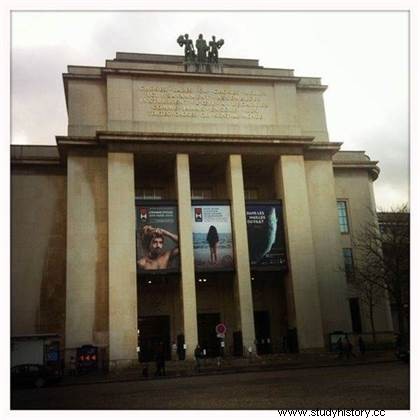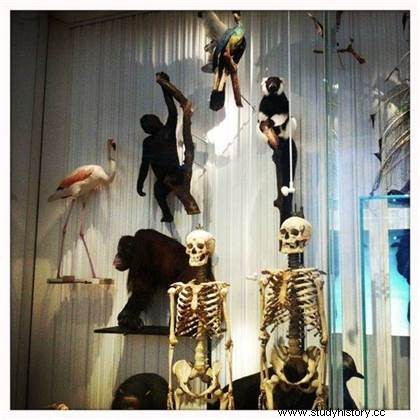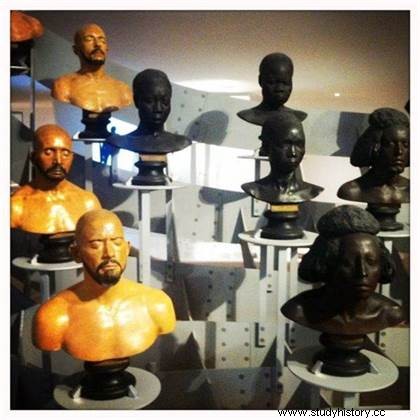 Founded in 1938 and located on Place du Trocadéro in Paris, the Musée de l'Homme> is intended to bring together everything that contributes to the natural and cultural definition of the human being. Retracing the evolution of man since his origins, the museum offers a circuit by geographical area where the different societies are evoked through their arts, their customs and their techniques. From 2003, the collections of the ethnographic departments of the musée de l'Homme were transferred to the new musée du quai Branly, which opened its doors in June 2006. For its part, which remained at the Trocadéro, the musée de l'Homme then launched in a total overhaul of the presentation of its collections, around the natural and cultural history of man:origins, singularities and cultural history of humanity.
Founded in 1938 and located on Place du Trocadéro in Paris, the Musée de l'Homme> is intended to bring together everything that contributes to the natural and cultural definition of the human being. Retracing the evolution of man since his origins, the museum offers a circuit by geographical area where the different societies are evoked through their arts, their customs and their techniques. From 2003, the collections of the ethnographic departments of the musée de l'Homme were transferred to the new musée du quai Branly, which opened its doors in June 2006. For its part, which remained at the Trocadéro, the musée de l'Homme then launched in a total overhaul of the presentation of its collections, around the natural and cultural history of man:origins, singularities and cultural history of humanity.
An ideal museum to educate children about diversity. And not only...
When night comes, does the exposed skull of Descartes (1596-1650) wake up to whisper to that of Neanderthal man:- "Cogito ergo sum ( 'I think therefore I am')! Cogito ergo sum!" ? What our very very distant cousin (-250,0000 to 28,000 BC), exasperated by the chorus, responds to with bellicose onomatopoeias? Does the saber-toothed tiger come out of its window to rush at the half-devoured elephant sculpture placed on the ground floor? What are the chachapoya mummy dating from the 9th century (discovered in the Peruvian Andes in 1877) and the totem-like inhabitant of Montreuil guarding the entrance debating about?
Enough joking but, on entering this spacious 2500m2 museum rich in a thousand treasures so different from each other, it is tempting to think of the American film 'A Night at the Museum ', during which each presentation comes to life. This somewhat incongruous thought reveals the playful and not at all precious aspect of the place, ideal for children and for adults usually impressed by the pomp of certain buildings. Toddlers will be able to shake hands with an ersatz chimpanzee, that of a Neanderthal man then that of a homo sapiens (all of us, human beings), just to compare. To feel the differences. To be flabbergasted by the similarities. They will be able to marvel at showcases bringing together living things in all their forms, from the stuffed Bornean orangutan to the strange beast that is the platypus.
Don't panic parents, no need to keep the smartphone or the Petit Robert in hand:educational sheets are highlighted to answer the thousand questions to come. In jars, the brain of a crow rubs shoulders with that of a human being. So distant. So close. Magic of anatomy.... (don't miss the wax masks from the 17th century) Get on a colorful bus from Dakar to see the landscape go by. Enter a Mongolian yurt. Pulling a tab on a giant map of the world to hear one of the 7,000 languages spoken by 7 billion humans across the planet (it puts it into perspective, doesn't it?) Experiments, based on evolution species like that of our human societies around the world, there is no shortage here for the little ones:get ready for a chatty and joyful day.
The Musée de l'Homme:a popular, scientific and committed institution
 If the museum, redesigned during the works, does not overwhelm the visitor, the building is nonetheless splendid . Housed in the Passy wing of the Palais de Chaillot, a stone's throw from the Eiffel Tower, it houses the magnificent glass roof by Davioud, protected as a Historic Monument. The project for this museum was led by Paul Rivet (1876-1958), anthropologist and politician. It was created in 1937 during the International Exhibition of Arts and Techniques, with the support of the Front Populaire. Inaugurated among others by Minister Jean Zay in 1938 (who would soon be the victim of a virulent anti-Semitic campaign, imprisoned by the Vichy government and then assassinated by militiamen in 1944), the museum intends to present to the general public the latest scientific advances in knowledge of evolutionary history.
If the museum, redesigned during the works, does not overwhelm the visitor, the building is nonetheless splendid . Housed in the Passy wing of the Palais de Chaillot, a stone's throw from the Eiffel Tower, it houses the magnificent glass roof by Davioud, protected as a Historic Monument. The project for this museum was led by Paul Rivet (1876-1958), anthropologist and politician. It was created in 1937 during the International Exhibition of Arts and Techniques, with the support of the Front Populaire. Inaugurated among others by Minister Jean Zay in 1938 (who would soon be the victim of a virulent anti-Semitic campaign, imprisoned by the Vichy government and then assassinated by militiamen in 1944), the museum intends to present to the general public the latest scientific advances in knowledge of evolutionary history.
And this, in a context of rising xenophobia and fascism. Presenting the origins and the morphological and cultural diversity of Man, it is then perceived as the most modern museum in the world. Moreover, to define the philosophy that has guided this place since its opening, the word to its designer, Paul Rivet:"Humanity is an indivisible whole, not only in space, but also in time." The rest, including wars and intolerance, one could explain, is nothing but mental construction and the particular interests of constructed societies.
Scientific facts, presented intelligently to question us
 In the center of the ground floor, the large bearing. 19 meters long, 11 meters high, connecting level 1 to level 2. 91 busts made in plaster and bronze during the 19th century. are perched on this aluminum rail. They represent human diversity. Our rich species in all its visual aspects. At the foot of the rail, photos of the infamous 19th century European 'human zoos', in which our fellow human beings, too exotic to the tastes of our smug ancestors, were exhibited like animals. A little aside, the story of the different hominids, numerous, more numerous than one might think to have walked the Earth (and probably not all of them have yet been discovered).
In the center of the ground floor, the large bearing. 19 meters long, 11 meters high, connecting level 1 to level 2. 91 busts made in plaster and bronze during the 19th century. are perched on this aluminum rail. They represent human diversity. Our rich species in all its visual aspects. At the foot of the rail, photos of the infamous 19th century European 'human zoos', in which our fellow human beings, too exotic to the tastes of our smug ancestors, were exhibited like animals. A little aside, the story of the different hominids, numerous, more numerous than one might think to have walked the Earth (and probably not all of them have yet been discovered).
The vast majority went a long way and then disappeared. Neanderthal lasted longer. Homo Sapiens won and now reigns alone. From then on, he invented differences. These three elements put side by side:no need for big speeches. The effect is guaranteed... So much hatred, death, humiliation, social constructions and artificial and destructive barriers while... This is undoubtedly the strength of this museum:it lets the visitor think, it does not impose nothing. In short, Descartes really has his place there. And no doubt many, including some politicians and religious creationists on the return, should take a leap. Yes, they should. It would save us a lot of bad winds.
Very great success, therefore, that this reopening which knew how to reconnect with the spirit of its creator. A knowledgeable and accessible museum, in which adults believe they are bringing their children to awaken them, but who come out awake themselves. Very complementary, moreover, to that of the Arts Premiers, quai Branly, more focused on societies around the world and time. Finally, as the sky darkens with heavy clouds, we have at our fingertips all the data and educational tools to fight racism and stupidity. What are we waiting for? Because the lethal weapon remains well, always and again:Knowledge.
Museum of Man. Chaillot Palace, Trocadero, Paris.
- Frédéric L'Helgoualch is the author of 'Deci-Delà (since nothing happens as planned)' at ed. from the Net.
